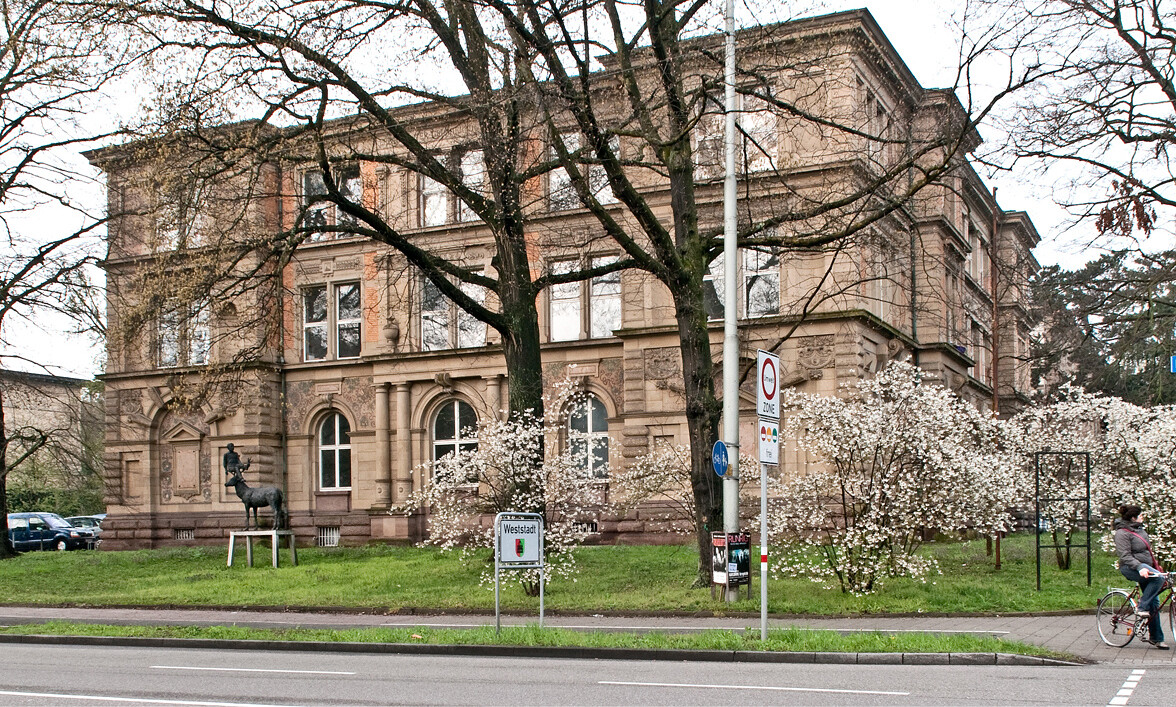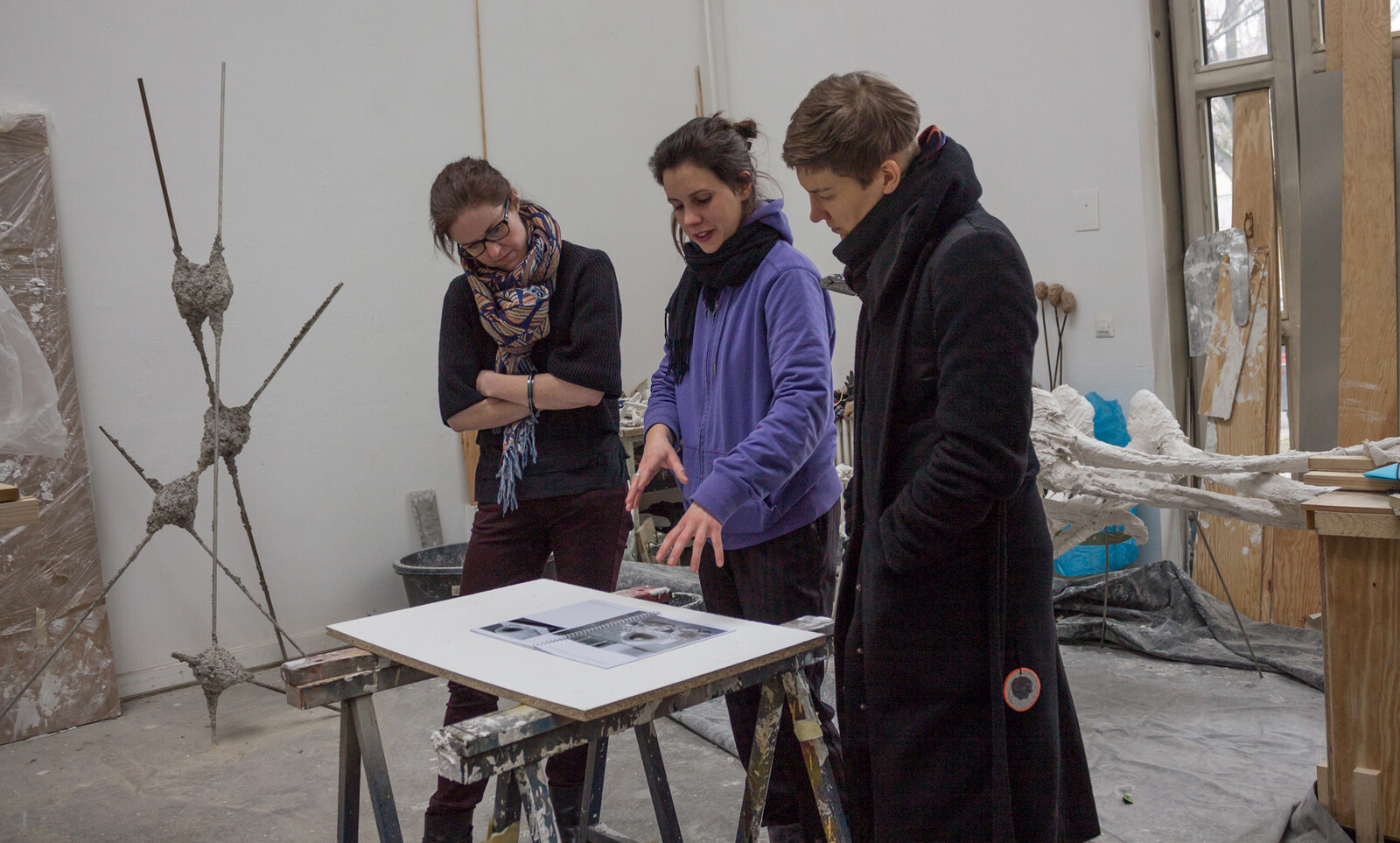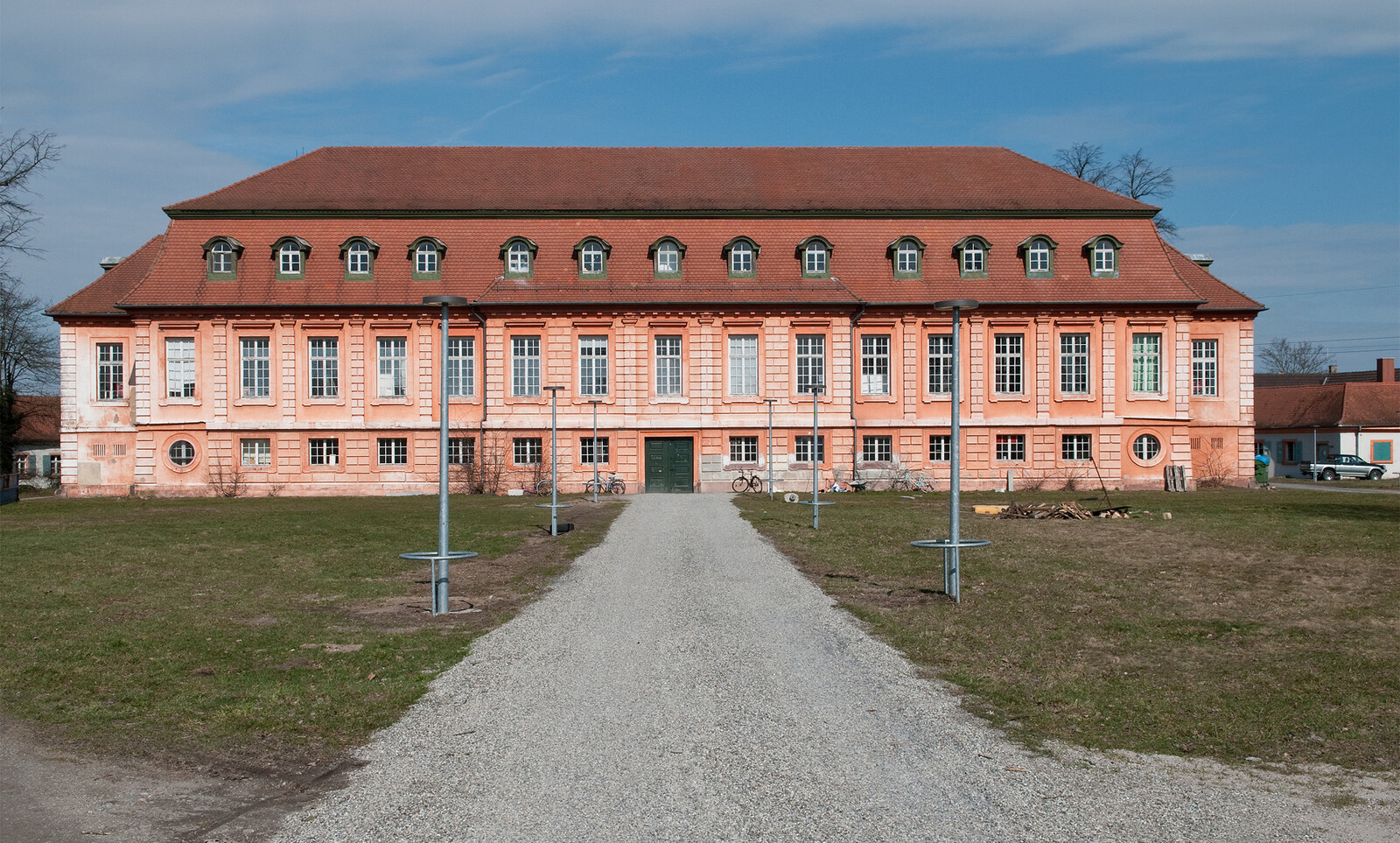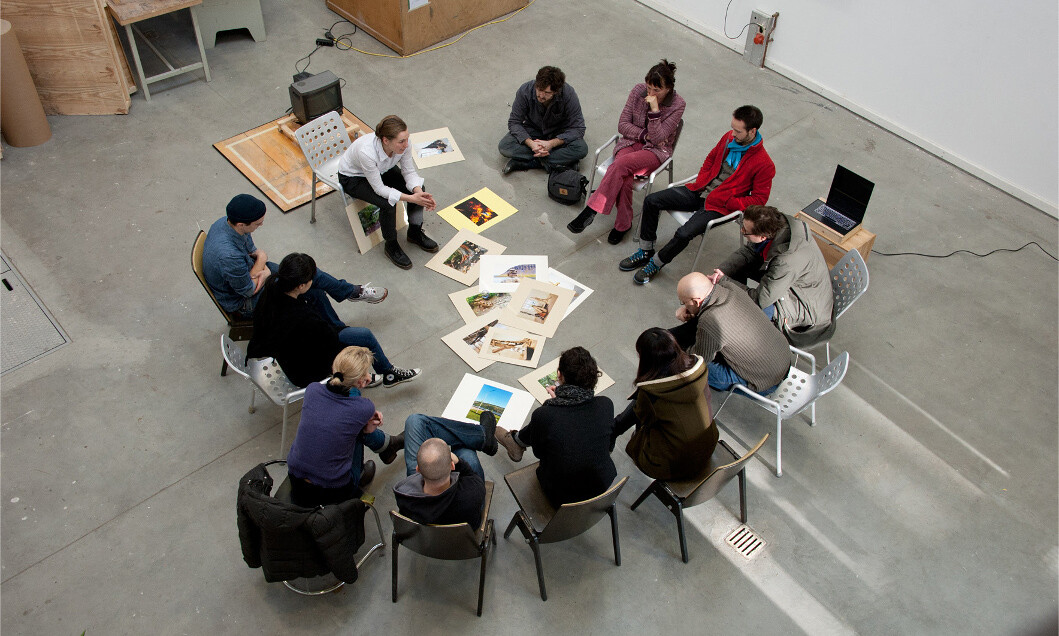http://www.kunstakademie-karlsruhe.de
A heavy set of keys in hand, I walked through the sculpture studios into the Kunstakademie’s garden, surprised by the location of my accommodation in Karlsruhe. By the streetlights, I could make out a repository of abandoned sculptural endeavours, some classical stone carvings overgrown with ivy, some recent experiments in new materials lying between trees. Nearing the end of the path, a stylish, massive, 1960s brick dwelling appeared, in a room of which I was to stay. The experience was illustrative of a school with a significant, though not well-known, heritage that today operates within classical traditions and contemporary challenges, informing and being informed by the historic city that surrounds it.
The first form of the Staatliche Akademie der Bildenden Künste Karlsruhe (State Academy of Fine Arts Karlsruhe) was founded in 1854 by Frederick I, Grand Duke of Baden. Then, education at the grand-ducal art school was intended for the sons of Baden’s nobility, while their daughters were allowed only in 1885 to attend a painting school which was later integrated into the academy. In the 1920s and early 1930s, the school rose to prominence as it fostered members of the Neue Sachlichkeit (New Objectivity), a movement that rebuffed the jingoism of pre-WWI Germany. New Objectivity ended with the Weimar Republic and, following the rise of National Socialism, several professors active in the movement were dismissed. This history was redressed in the postwar era with the reinstatement of a number of faculty members barred by the Nazis from teaching and the repair of physical damage suffered by the academy during the war. The school would then navigate the cultural landscape of the new West Germany and, in so doing, build that brick studio building in the garden to lure the once “degenerate,” but by then celebrated, artist Georg Meistermann to Karlsruhe by offering him a studio in which he could design his monumental works.
Today, the school is home to 296 students studying fine art, of whom a quarter are concurrently training to become art educators. Per the German tradition, students are accepted into a professor’s Klasse, or class, in which they are likely to remain for all ten semesters of their studies. Just whom one studies under is a key point of a young German artist’s CV. Alongside the generously proportioned professors’ studios where the students in a given class have their own spaces, the academy—one of the smallest in Germany—has enviable facilities in twelve separate workshops where tutors provide a technical education to help students realize their work in lithography, carpentry, casting, etching, video, digital media, monumental painting, photography, and a few unofficial practices, like glassblowing. Painting technique has its own workshop, and anatomy lessons are offered as well. Theory complements this practical pedagogy, with two art history professors and one art and theory professor working alongside the seventeen artist-professors. This ratio is revealing: while other art schools are theory-driven and many students struggle to translate the concepts they learn into visual form, in Karlsruhe theory plays a supporting role to painting and sculpture.
Thus, studio practice is the lodestone of an artistic training in which, at best, the professor-student system generates an intimate and supportive micro-community in which all students work side by side, guided and challenged by an attentive professor. The youngest students may be just seventeen when they join the academy, and develop their practices and perspectives as they mature alongside their peers who are at least four formative years ahead of them. The faculty at AdBK Karlsruhe ranges from long-established figures such as Stephan Balkenhol and Harald Klingelhöller and famous names like John Bock and Corinne Wasmuht to a new generation represented by Kalin Lindena and Tatjana Doll. Erstwhile Karlsruhe professors, for longer or shorter periods, include Per Kirkeby, Markus Lüpertz, Georg Baselitz, Katharina Fritsch, Katharina Grosse, and Elke Krystufek.
In general, the professor-led class system may seem unfathomable to students accustomed to media-based and seminar-heavy education, though that puts its strengths and weaknesses in plainer contrast. Major names, for example, look great on paper, but the most successful artists may not be the most attentive teachers if their own careers take them too often away from the classroom. On the other hand, their students will likely benefit from an entrée into the artists’ own working network rather than merely learning the theory of being an artist. Another oddity of this tradition is that many professors have jobs for life, if they wish—enviable stability for an artist, but a potential drawback if a school requires innovation. Perhaps this is the reason why the Kunstakademie Karlsruhe does not fill vacant positions immediately. Last year, Henning Strassburger had an interim role in the painting department prior to Ulla von Brandenburg assuming a professorship, while Markus Vater is currently mentoring Silvia Bächli’s class following her retirement.
Each of the sixteen professors’ classes have approximately twenty students, not including visiting students and the prestigious “Meisterschüler,” graduating students who are given the opportunity to study with the professor and class for an additional year and to further enjoy the facilities and access the academy offers. (Karlsruhe—along with many German art schools—is not harmonized with the Bologna Process BA/MA system, and the graduating students receive the standard German art school “Diplom” qualification. After ten semesters, students training to become art educators, however, are awarded the MA required to teach art at the Gymnasium level.)
The ideal professor at the Kunstakademie seems to be an itinerant one busy with exhibitions and personal projects away from Karlsruhe, but regularly on site for intense interactions with her charges. On a recent visit, I met professors Marcel von Eeden and Ulla von Brandenburg, weary but happy after a long day of studio crits with their combined classes—a rarity, in this case, where all students presented their work to the whole group, as crits are usually attended only by one class or conducted in private between professor and student. Van Eeden splits his time between Zurich and his native Netherlands while von Brandenburg, originally from Karlsruhe, has since established herself in Paris. That evening, von Brandenburg’s room at the academy was cleared to make way for a meal cooked as a gesture of thanks by her students for their recent trip to Paris, during which she introduced them to some of the city’s art venues. After dinner, the importance and intimate nature of the German professor-student relationship was becoming clear: professors bear a huge responsibility to guide their students over several formative years, in and out of the studio, and introduce them to the world beyond the academy.
AdBK Karlsruhe supports class trips each semester and links across Europe are fostered through the Erasmus scheme. With the support of the federal state of Baden Württemberg, the school also facilitates exchange programs through ongoing partnerships with the École Régionale des Beaux-Arts de Saint-Etienne in France and the Escuela Nacional de Pintura Escultura y Grabado in Mexico City. Without travelling, a degree of international perspective is still possible for students in Karlsruhe, a city of 300,000 with decent cultural offerings on a par with those in Munich or Berlin in quality, if not quantity. The ZKM (Zentrum für Kunst und Medien, Center for Art and Media, which encompasses a Museum for New Art and a Media Museum) is the city’s contemporary art star, thanks to director Peter Weibel, who calls his institution a “mecca for media art.” (Karlsruhe is an important site for the IT and communications industries.)
The other Karlsruhe art school—the Staatliche Hochschule für Gestaltung, State Design School, or HfG, which has departments across the design spectrum as well as in film, game design, and photography—shares a campus with and was founded at the same time as the ZKM. HfG provides a contemporary counterpoint to the academy’s classical position, and the schools strive to maintain that distinction, between the HfG’s practical, media-led orientation and the academy’s history of autonomous art study. Nonetheless, the academy also has links to the ZKM, particularly through Axel Heil, a polymath who operates a satellite professorship entitled “Experimentelle Transferverfahren,” an inspiring field for which the translation of “experimental transfer processes” seems rather inadequate. (He told me that he spurned the label of “new media” given that this year’s new is next year’s old.) Heil’s course is an exception to the class rule, as his students are mentored by other professors. Still, it offers students training in various media forms as well as guidance on projects such as the Meisterschüler’s annual catalogue, a generous visual document of each student’s work. In Heil’s course, students have benefited from his curatorial and artistic projects, including the reconstruction of Aby Warburg’s Mnemosyne Bilderatlas and involvement with exhibitions of Paul Thek and William Burroughs at the ZKM, to mention only a few recent examples.
Beyond the ZKM, Staatliche Kunsthalle Karlsruhe houses, in its neoclassical building, an excellent collection of medieval, Renaissance, and Netherlandish prints and modern contemporary art. A recent exhibition comparing works of Albrecht Dürer with ones by William Kentridge reflects the Kunsthalle’s broad mission. The city’s Badischer Kunstverein touts an equally impressive history as the second-oldest Kunstverein in the country, though its program is thoroughly contemporary. Commercially, Meyer Riegger gallery maintains a space in Karlsruhe, but most money goes elsewhere—as of course do students. Stuttgart, Frankfurt, and Strasbourg are all about an hour’s journey from Karlsruhe. Not to mention that the world comes to the academy as well; I was there after I was invited to curate a series of artists’ talks sponsored by the Riemschneider Foundation this academic year, bringing Pilvi Takala, Sophie Jung, and Sean Lynch to present to students and conduct studio visits. Among other academy events, philosopher Jean-Luc Nancy recently gave a lecture on his work and activist and artist Warren Neidich is to visit in April.
The emphasis on technical skill in painting, drawing, sculpture, and newer media at the academy makes it an enticing option for committed and hungry young art makers. Commitment is a prerequisite at the academy, with its tight-knit community informed by the scrutiny of the Klasse system and its rich, closely engaged faculty. It is little wonder that the school has seen increased interest from would-be students from beyond the EU, despite the fact that nearly all instruction is in German. Nominal fees make it attractive too, of course, though these advantageous financial conditions may soon change with Germany’s political climate. The challenge for the emerging artist in Karlsruhe is to exploit the opportunities they have—the studio spaces and the historic framing for their work, the outstanding workshops at their disposal—while not getting too settled. Their studies are comparatively, luxuriously long, but real life awaits afterwards. John Bock, Erwin Gross, and Corinne Wasmuht’s classes billeted in the late seventeenth-century hunting lodge Schloss Scheibenhardt on the southern outskirts of the city might sometimes forget this, but the fairy tale does end.
—Aoife Rosenmeyer





